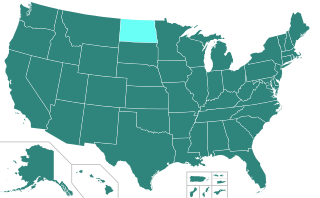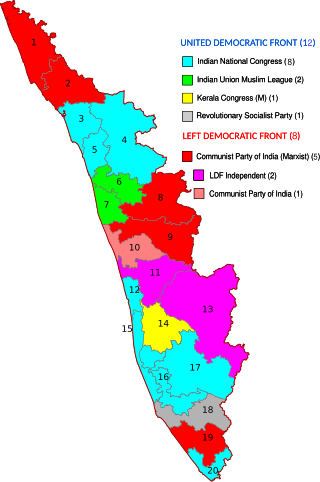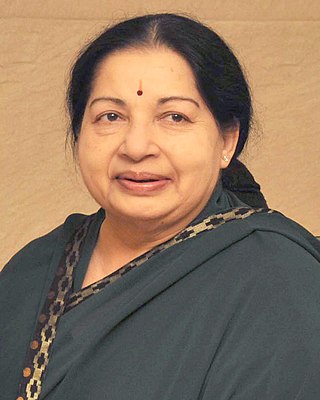Related Research Articles
The incumbent is the current holder of an office or position, usually in relation to an election. In an election, the incumbent is said to be the person holding or acting in the position that is up for election, whether if the said officeholder is seeking re-election or not. In some situations, there may not be an incumbent at time of an election for that office or position, usually after the incumbent dies, retires, resigns, does not seek re-election, is barred from re-election due to term limits, or a new electoral division or position is created, at which point the office or position is regarded as vacant or open. In the United States, an election without an incumbent on the ballot is often referred to as an open seat or open contest.

In political science, voter turnout is the participation rate of a given election. This is typically either the percentage of registered voters, eligible voters, or all voting-age people. According to Stanford University political scientists Adam Bonica and Michael McFaul, there is a consensus among political scientists that "democracies perform better when more people vote."

The youth vote in the United States is the cohort of 18–24 year-olds as a voting demographic, though some scholars define youth voting as voters under 30. Many policy areas specifically affect the youth of the United States, such as education issues and the juvenile justice system; however, young people also care about issues that affect the population as a whole, such as national debt and war.

The 1886 Ontario general election was the sixth general election held in the Province of Ontario, Canada. It was held on December 28, 1886, to elect the 90 Members of the 6th Legislative Assembly of Ontario ("MLAs"). The election results were characterized a "crushing defeat for the Conservatives.
Congressional stagnation is an American political theory that attempts to explain the high rate of incumbency re-election to the United States House of Representatives. In recent years this rate has been well over 90 per cent, with rarely more than 5-10 incumbents losing their House seats every election cycle. The theory has existed since the 1970s, when political commentators were beginning to notice the trend, with political science author and professor David Mayhew first writing about the "vanishing marginals" theory in 1974.

Voter registration in the United States is required for voting in federal, state and local elections in the United States. The only exception is North Dakota, although cities in North Dakota may register voters for city elections. Voter registration takes place at the county level in many states and at the municipal level in several states. Most states set cutoff dates for voter registration and to update details, ranging from 2 to 4 weeks before an election; while a third of states have Election Day or "same-day" voter registration which enables eligible citizens to register or update their registration when they vote before or on election day.

General elections were held in India in five phases between 16 April 2009 and 13 May 2009 to elect the members of the fifteenth Lok Sabha. With an electorate of 716 million, it was the largest democratic election in the world until being surpassed by the 2014 general election.

General elections were held in India between 25 October 1951 and 21 February 1952. India attained independence on 15 August 1947 and set up an Election Commission two years later. In March 1950, Sukumar Sen was appointed as the first Chief Election Commissioner. A month later, the Indian Parliament passed the Representation of the People Act which provided the conduct for election for the Houses of Parliament and the Houses of Legislature for each state. It was conducted under the provisions of the Indian Constitution, which was adopted on 26 November 1949. Elections to most of the state legislatures took place simultaneously.

The 2010 United States elections were held on Tuesday, November 2, 2010, in the middle of Democratic President Barack Obama's first term. Republicans ended unified Democratic control of Congress and the presidency by winning a majority in the House of Representatives and gained seats in the Senate despite Democrats holding Senate control.
In political science, political apathy is a lack of interest or apathy towards politics. This includes voter apathy, information apathy and lack of interest in elections, political events, public meetings, and voting.

General elections were held in India in nine phases from 7 April to 12 May 2014 to elect the members of the 16th Lok Sabha. With 834 million registered voters, they were the largest-ever elections in the world until being surpassed by the 2019 elections. Around 23.1 million or 2.7% of the total eligible voters were aged 18–19 years. A total of 8,251 candidates contested the 543 elected Lok Sabha seats. The average election turnout over all nine phases was around 66.40%, the highest ever in the history of Indian general elections.

The historical trends in voter turnout in the United States presidential elections have been determined by the gradual expansion of voting rights from the initial restriction to white male property owners aged 21 or older in the early years of the country's independence to all citizens aged 18 or older in the mid-20th century. Voter turnout in United States presidential elections has historically been higher than the turnout for midterm elections.
Elections for the Indian state of Jammu and Kashmir were held over seven days in November and December 2008. The previous government led by the Jammu and Kashmir People's Democratic Party (PDP) in coalition with the Indian National Congress (INC) collapsed when the PDP withdrew. Following the election, the Jammu & Kashmir National Conference (NC) agreed on a coalition with Congress and their leader, Omar Abdullah became the state's youngest-ever Chief Minister at 38.
The elections in 2012 were scheduled for seven Vidhan Sabhas and several local elections were also conducted. The 14th presidential election to elect the 13th president of the republic was also held in 2012. The tenure of the legislative assemblies of Goa, Gujarat, Himachal Pradesh, Manipur, Punjab, Uttar Pradesh and Uttarakhand were to expire during the year. The Election Commission of India issued the dates for the elections in Manipur, Punjab, Uttarakhand, Uttar Pradesh and Goa to take place in the first quarter of the year. Whereas the elections were held in Himachal Pradesh and Gujarat in the last quarter of the year.

The 2014 United States elections were held on Tuesday, November 4, 2014, in the middle of Democratic President Barack Obama's second term. Republicans retained control of the House of Representatives and won control of the Senate.
Legislative Assembly elections in India were conducted for nine legislative assemblies in 2013. Voting in Chhattisgarh was held in two phases on 11 November and 19 November 2013. The Election Commission of India (ECI) successfully conducted elections in Tripura, Meghalaya and Nagaland in February and in Karnataka on 5 May. The elections in Chhattisgarh, Delhi, Madhya Pradesh and Rajasthan were conducted in December while the counting that took place on 8 December showed a clear majority for BJP in the states of Madhya Pradesh, Rajasthan and Chhattisgarh, while Congress retained the state of Mizoram and Delhi got a hung assembly, with no single party getting a clear majority.

The 2014 Indian general election polls in Kerala were held for the twenty Lok Sabha seats in the state on 10 April 2014. The total voter strength of Kerala for the election was 2,42,51,937 and 73.89% of voters exercised their right to do so. The results of the elections were declared on 16 May 2014.

The Fifteenth Legislative Assembly Election was held on 16 May 2016 for the 232 seats of the Legislative Assembly in the state of Tamil Nadu in India. The AIADMK under J. Jayalalithaa won the elections and became the first ruling party to be re-elected in Tamil Nadu since 1984, though with a simple majority. The DMK won half of the seats it contested but its allies performed poorly; notably, the Indian National Congress won 16% of the seats they contested, and the alliance lost due to its poor performance. The votes were counted on 19 May 2016. In the previous election in 2011, AIADMK, under the leadership of Jayalalithaa, won a thumping majority and formed the government, while DMDK chief Vijayakanth served as the Leader of Opposition until January 2016. This was the last election that J. Jayalalithaa and M. Karunanidhi contested, as they both died in 2016 and 2018 respectively.

The 2017 Uttarakhand Legislative Assembly election was the 4th Vidhan Sabha election of the state of Uttarakhand in India. Elections were held on 15 February 2017 in a single phase for the 69 seats of the Uttarakhand Legislative Assembly. Voting in the Karnaprayag constituency was postponed until 9 March 2017 due to the death of BSP candidate Kuldeep Kanwasi in a road accident. In the previous election in 2012, none of the parties won a majority but the Indian National Congress formed the government with the help of PDF with the leadership of Vijay Bahuguna.

The Bihar Legislative Assembly election was held in three phases through October–November to elect members to the Seventeenth Bihar Legislative Assembly. The term of the previous Sixteenth Legislative Assembly of Bihar ended on 29 November 2020.
References
- 1 2 Kennedy, David M. (6 November 2010). "Throwing the Bums Out for 140 Years". The New York Times.
- ↑ Baker, Andy (2015). "Public Mood and Presidential Election Outcomes in Mexico" (PDF). University of Colorado Boulder. Archived from the original (PDF) on Jun 10, 2023.
- ↑ Bartels, Larry M. "The Irrational Electorate" (PDF). The Wilson Quarterly. Archived from the original (PDF) on Jan 17, 2023.
- ↑ Johnson, Thomas J.; Lee, Angela M. (December 2015). "Kick the bums out?: A structural equation model exploring the degree to which mainstream and partisan sources influence polarization and anti-incumbent attitudes". Electoral Studies. 40: 210–220. doi:10.1016/j.electstud.2015.08.008.
- 1 2 Bochsler, Daniel; Hänni, Miriam (February 2019). "The three stages of the anti-incumbency vote: Retrospective economic voting in young and established democracies". European Journal of Political Research. 58 (1): 30–55. doi:10.1111/1475-6765.12269.
- ↑ "Anti-incumbency grips Bhutan". The Economist. 2018-10-11.
- ↑ "Anti-incumbency in our DNA".
- ↑ "Incumbency in India: More Curse Than Blessing?".
- ↑ Counting on Anti-Incumbency Economic and Political Weekly, 24 March 2001, Vol.36(12), pp.981-981
- ↑ Goled, Shraddha (2019-03-13). "TLI Explains: What is Anti-Incumbency & How Does It Affect the Fate of Parties".
- ↑ "The quiet decline of anti-incumbency". Gateway House. 2015-02-24. Retrieved 2020-08-30.
- ↑ Vaishnav, Milan; Guy, Johnathan (4 April 2018). "Does Higher Turnout Hurt Incumbents? An Analysis of State Elections in India". Studies in Indian Politics. 6 (1): 71–87. doi: 10.1177/2321023018762817 .
- ↑ "Why the government should worry about the warning signs of anti-incumbency".
- ↑ An Anti-Incumbency Wave -- in Mexico. Krauze, Enrique The New York Times, July 7, 2010, p.A21(L)
- ↑ Myers, Dee Dee (27 July 2016). "New Technology and the 1992 Clinton Presidential Campaign". American Behavioral Scientist. 37 (2): 181–184. doi:10.1177/0002764293037002003. S2CID 145133140.
- ↑ Savo, Alyssa. "The Fight for Term Limits: Reinvestigating DeMint's Defense of His Failed Amendment" (PDF). American University. Archived from the original (PDF) on Jan 17, 2023.
For instance, a 2013 NBC News/Wall Street Journal poll found 60% of Americans said that they would vote to "defeat and replace every single member of Congress, including [their] own representative" if they could (Montanero).
- ↑ "The anti-incumbent election is a myth". Politico .
- ↑ "Anti-incumbency's threat to judicial selection". Judicature. 76 (2): 56. 1992.
- ↑ "The quiet decline of anti-incumbency". 2015-02-24.